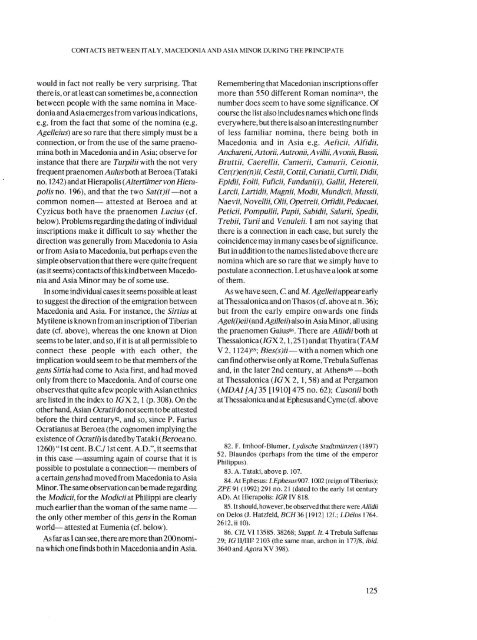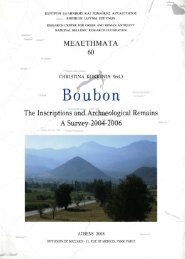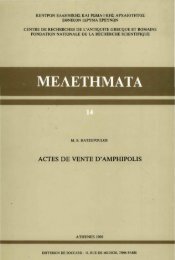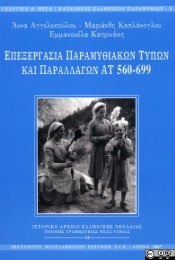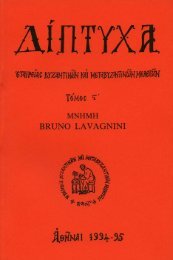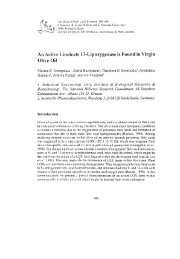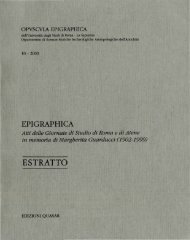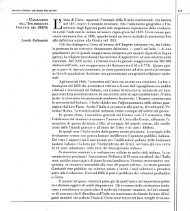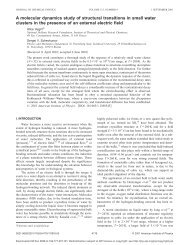Roman onomastics in the Greek East: social and political aspects ...
Roman onomastics in the Greek East: social and political aspects ...
Roman onomastics in the Greek East: social and political aspects ...
Create successful ePaper yourself
Turn your PDF publications into a flip-book with our unique Google optimized e-Paper software.
CONTACTS BETWEEN ITALY, MACEDONIA AND ASIA MINOR DURING THE PRINCIPATE<br />
would <strong>in</strong> fact not really be very surpris<strong>in</strong>g. That<br />
<strong>the</strong>re is, or at least can sometimes be, a connection<br />
between people with <strong>the</strong> same nom<strong>in</strong>a <strong>in</strong> Macedonia<br />
<strong>and</strong> Asia emerges from various <strong>in</strong>dications,<br />
e.g. from <strong>the</strong> fact that some of <strong>the</strong> nom<strong>in</strong>a (e.g.<br />
Agelleius) are so rare that <strong>the</strong>re simply must be a<br />
connection, or from <strong>the</strong> use of <strong>the</strong> same praenom<strong>in</strong>a<br />
both <strong>in</strong> Macedonia <strong>and</strong> <strong>in</strong> Asia; observe for<br />
<strong>in</strong>stance that <strong>the</strong>re are Turpilii with <strong>the</strong> not very<br />
frequent praenomen Aulusboth at Beroea (Tataki<br />
no. 1242) <strong>and</strong> at Hierapolis (Altertümer von Hierapolis<br />
no. 196), <strong>and</strong> that <strong>the</strong> two Sat(t)ii —not a<br />
common nomen— attested at Beroea <strong>and</strong> at<br />
Cyzicus both have <strong>the</strong> praenomen Lucius (cf.<br />
below). Problems regard<strong>in</strong>g <strong>the</strong> dat<strong>in</strong>g of <strong>in</strong>dividual<br />
<strong>in</strong>scriptions make it difficult to say whe<strong>the</strong>r <strong>the</strong><br />
direction was generally from Macedonia to Asia<br />
or from Asia to Macedonia, but perhaps even <strong>the</strong><br />
simple observation that <strong>the</strong>re were quite frequent<br />
(as it seems) contacts of this k<strong>in</strong>d between Macedonia<br />
<strong>and</strong> Asia M<strong>in</strong>or may be of some use.<br />
In some <strong>in</strong>dividual cases it seems possible at least<br />
to suggest <strong>the</strong> direction of <strong>the</strong> emigration between<br />
Macedonia <strong>and</strong> Asia. For <strong>in</strong>stance, <strong>the</strong> Sirtius at<br />
Mytilene is known from an <strong>in</strong>scription of Tiberian<br />
date (cf. above), whereas <strong>the</strong> one known at Dion<br />
seems to be later, <strong>and</strong> so, if it is at all permissible to<br />
connect <strong>the</strong>se people with each o<strong>the</strong>r, <strong>the</strong><br />
implication would seem to be that members of <strong>the</strong><br />
gens Sirtia had come to Asia first, <strong>and</strong> had moved<br />
only from <strong>the</strong>re to Macedonia. And of course one<br />
observes that quite a few people with Asian ethnics<br />
are listed <strong>in</strong> <strong>the</strong> <strong>in</strong>dex to IGX 2,1 (p. 308). On <strong>the</strong><br />
o<strong>the</strong>r h<strong>and</strong>, Asian Ocratii do not seem to be attested<br />
before <strong>the</strong> third century 82 , <strong>and</strong> so, s<strong>in</strong>ce P. Farius<br />
Ocratianus at Beroea (<strong>the</strong> cognomen imply<strong>in</strong>g <strong>the</strong><br />
existence of Ocratii) is datedby Tataki (Beroeano.<br />
1260) "1st cent. B.C./ 1st cent. A.D.", it seems that<br />
<strong>in</strong> this case —assum<strong>in</strong>g aga<strong>in</strong> of course that it is<br />
possible to postulate a connection— members of<br />
a certa<strong>in</strong> gens had moved from Macedonia to Asia<br />
M<strong>in</strong>or. The same observation can be made regard<strong>in</strong>g<br />
<strong>the</strong> Modicii, for <strong>the</strong> Modicii at Philippi are clearly<br />
much earlier than <strong>the</strong> woman of <strong>the</strong> same name —<br />
<strong>the</strong> only o<strong>the</strong>r member of this gens <strong>in</strong> <strong>the</strong> <strong>Roman</strong><br />
world— attested at Eumenia (cf. below).<br />
As far as I can see, <strong>the</strong>re are more than 200 nom<strong>in</strong>a<br />
which one f<strong>in</strong>ds both <strong>in</strong> Macedonia <strong>and</strong> <strong>in</strong> Asia.<br />
Remember<strong>in</strong>g that Macedonian <strong>in</strong>scriptions offer<br />
more than 550 different <strong>Roman</strong> nom<strong>in</strong>a 83 , <strong>the</strong><br />
number does seem to have some significance. Of<br />
course <strong>the</strong> list also <strong>in</strong>cludes names which one f<strong>in</strong>ds<br />
everywhere, but <strong>the</strong>re is also an <strong>in</strong>terest<strong>in</strong>g number<br />
of less familiar nom<strong>in</strong>a, <strong>the</strong>re be<strong>in</strong>g both <strong>in</strong><br />
Macedonia <strong>and</strong> <strong>in</strong> Asia e.g. Aeficii, Alfidii,<br />
Anchareni, Artorii, Autronii,Avillii, Avonii, Bassii,<br />
Bruttii, Caerellii, Cameni, Camurii, Ceionii,<br />
Cer(r)en(n)ii, Cestii, Cottii, Curiata, Curtii, Didii,<br />
Epidii, Folii, Fuficii, Fundani(i), Gallii, Hetereii,<br />
Lardi, Lartidii, Magnii, Modii, Mundicii, Mussii,<br />
Naevii, Novella, Olii, Opetreii, Orfidii, Peducaei,<br />
Fetidi, Pompullii, Pupii, Sabidii, Salarli, Spedii,<br />
Trebii, Turii <strong>and</strong> Venuleii. I am not say<strong>in</strong>g that<br />
<strong>the</strong>re is a connection <strong>in</strong> each case, but surely <strong>the</strong><br />
co<strong>in</strong>cidence may <strong>in</strong> many cases be of significance.<br />
But <strong>in</strong> addition to <strong>the</strong> names listed above <strong>the</strong>re are<br />
nom<strong>in</strong>a which are so rare that we simply have to<br />
postulate a connection. Let us have a look at some<br />
of <strong>the</strong>m.<br />
As we have seen, C. <strong>and</strong> M. Agelleiiappear early<br />
at Thessalonica <strong>and</strong> on Thasos (cf. above at n. 36);<br />
but from <strong>the</strong> early empire onwards one f<strong>in</strong>ds<br />
Agel(l)eii (<strong>and</strong> Agilleii) also <strong>in</strong> Asia M<strong>in</strong>or, all us<strong>in</strong>g<br />
<strong>the</strong> praenomen Gaius 84 . There are Allidii both at<br />
Thessalonica (IGX 2,1,251 ) <strong>and</strong> at Thyatira ( ΤΑΜ<br />
V 2,1124) 85 ; Bies(s)ii—with a nomen which one<br />
can f<strong>in</strong>d o<strong>the</strong>rwise only at Rome, Trebula Suffenas<br />
<strong>and</strong>, <strong>in</strong> <strong>the</strong> later 2nd century, at A<strong>the</strong>ns 86 —both<br />
at Thessalonica (IGX 2,1,58) <strong>and</strong> at Pergamon<br />
(MDAI[A]35 [1910] 475 no. 62); Cusonii both<br />
at Thessalonica <strong>and</strong> at Ephesus <strong>and</strong> Cyme (cf. above<br />
82. F. Imhoof-Blumer, Lydische Stadtmünzen (1897)<br />
52, Blaundos (perhaps from <strong>the</strong> time of <strong>the</strong> emperor<br />
Philippus).<br />
83. A. Tataki, above p. 107.<br />
84. At Ephesus: I.Ephesus907.1002 (reign ofTiberius);<br />
ZPE9\ (1992)291 no. 21 (dated to <strong>the</strong> early 1st century<br />
AD). At Hierapolis: IGRIV 818.<br />
85. It should, however, be observed that <strong>the</strong>re were Allidii<br />
on Delos (J. Hatzfeld, BCH36 [1912] 12f.; I.Délos 1764.<br />
2612, ii 10).<br />
86. CIL VI13585. 38268; Suppl. It. 4 Trebula Suffenas<br />
29; IG II/III 2 2103 (<strong>the</strong> same man, archon <strong>in</strong> 177/8, ibid.<br />
3640 <strong>and</strong> Agora XV 398).<br />
125


